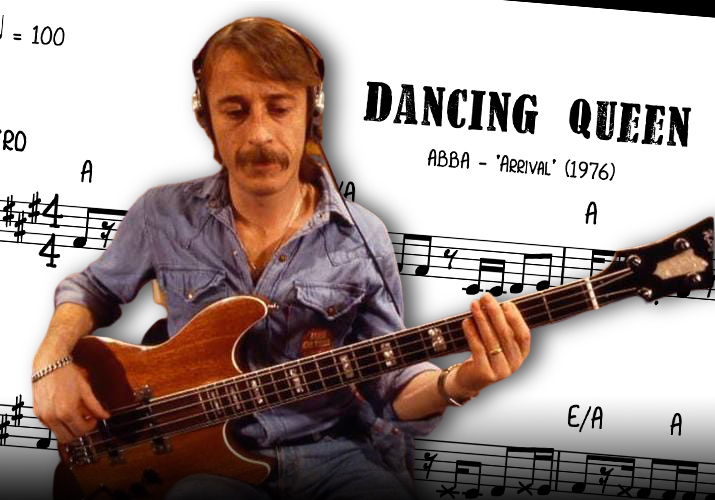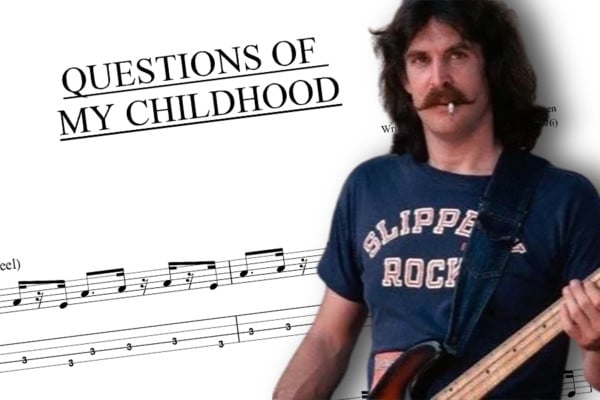Bass Transcription: Rutger Gunnarsson’s Bass Line on “Dancing Queen” by ABBA

“Dancing Queen” was the first single from ABBA’s 1976 Arrival album, topping the charts in 15 countries and remaining one of ABBA’s best-known songs. Apparently, Bjorn Ulvaeus and Benny Andersson were inspired by the feel of George McCrae’s 1974 hit “Rock Your Baby” and the track was one of the band’s attempts at a European take on disco, complete with sweeping string lines, soaring vocal melodies and a funky, syncopated bass part.
As with much of ABBA’s material, the superb bass playing comes courtesy of Rutger Gunnarsson, one of the band’s long-term musical collaborators. Rutger started playing bass with an early incarnation of the band in 1972 while he was studying classical guitar at Stockholm’s Royal College of Music. Although he wasn’t the only bassist to appear on the band’s recordings, he handled the lion’s share of the bass duties as well as arranging string and horn parts for many of ABBA’s songs.
“Dancing Queen” Bass Line Analysis
The bass line of “Dancing Queen” is a great example of a part that manages to combine rhythmic interest with melodic phrases and yet somehow never gets in the way of the vocals.
The main groove that anchors the introduction and verse sections revolve around a two-bar pattern played with subtle variations each time it repeats. Notice how Rutger uses contrasting fills at the end of each bar – the first fill uses a classic 5th-6th-octave pattern found in countless Motown and R’n’B recordings, while the second uses a combination of scalar and chromatic notes to move from the low E back to the A pedal. These alternate endings provide the part with contrast and give the line a ‘question and answer’ feel, a feature shared by many other influential bass lines including “Good Times”, “Walking On The Moon” and “Another One Bites The Dust”. I’ve tried to be as precise as possible with note lengths and articulation throughout, as they have a huge impact on how the line sits with the other instruments in the track. Rutger seems to almost always play the first note of each bar as an exact 8th-note, leaving a little breathing space before the ghost note that anticipates beat two.
When the harmony moves away from the A pedal in bar 9, Rutger’s bass part becomes more rhythmically active and makes frequent use of ghost notes and chromatic approaches, showing the influence of legendary Motown bassist James Jamerson. Bar 12 shows Rutger opting to play the 3rdof the B7 chord rather than the root, which initially provides more tension but also provides a smoother transition to the D chord in bar 13.
The verse covers similar ground to the introduction, with the familiar 5th-6th-octave figure from the introduction transposed to fit the E7 harmony (bars 24 and 25). As with previous sections, there’s plenty of rhythmic and melodic variation throughout – check out how seamlessly he moves in and out of the high register fill in bar 31.
The remainder of the song features further variations on the main theme, with liberal use of 16th-note syncopation and chromaticism throughout. Some of my favorite moments are the expressive slides in bar 65 and tension created in bar 79 by using C natural as an approach note to the B minor chord rather than the diatonically ‘correct’ C#.
Follow along with the transcription and the video below.




Great song! Nice analysis and transcription.
Hello, as always, great choice. Very famous song, but still a lot of people don´t notice how much of the credit this busy bassline deserves. I already have one older transcription so comparation will be interesting. I see from the first sight that there are differences in almost any bar. It will be fun to compare.
The analysis is also very useful.
Thank you for your good work.
…….downloaded, I am studying it.
Yes Gunnarsson is a genius, you guys should do a transcription on what he played on “One of us”